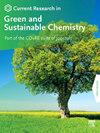Absorbance study on the adsorptive removal of Fe(III) ions using activated carbon from coconut shells
Q2 Materials Science
Current Research in Green and Sustainable Chemistry
Pub Date : 2025-01-01
DOI:10.1016/j.crgsc.2025.100458
引用次数: 0
Abstract
This study explores the adsorption kinetics and capacity of Fe(III) ions from aqueous solutions onto activated carbon synthesized from coconut shells. The carbonization process was conducted at 700 °C for 1 h, followed by activation with zinc chloride (ZnCl2) as the activating agent. The resulting activated carbon was characterized using nitrogen adsorption isotherms, X-ray diffraction (XRD), and scanning electron microscopy coupled with energy-dispersive X-ray spectroscopy (SEM-EDS). The absorbance of Fe(III) solutions was quantitatively analyzed using UV–Vis spectroscopy. Activated carbon derived from coconut shells was employed as an adsorbent for Fe(III) Nitrate solutions. The study systematically investigated several parameters influencing the adsorption process, including initial ion concentration, contact time, and varying weights of activated carbon. Characterization results indicated a specific surface area of 490.29 m2/g, with a predominately amorphous aromatic carbon structure and a carbon content of approximately 86.41 % by weight. The maximum adsorption capacity for Fe(III) Nitrate was observed to be 60.95 mg/g for a carbon weight of 0.005 g and 50.95 mg/g for a carbon weight of 0.01 g. Notably, the highest removal efficiency reached 83.81 % with an activated carbon weight of 0.5 g.
活性炭吸附去除椰子壳中铁(III)离子的吸光度研究
本研究探讨了水溶性铁(III)离子在椰壳活性炭上的吸附动力学和吸附能力。炭化过程在700℃下进行1 h,然后以氯化锌(ZnCl2)为活化剂进行活化。采用氮吸附等温线、x射线衍射(XRD)、扫描电镜和能量色散x射线能谱(SEM-EDS)对活性炭进行了表征。用紫外可见光谱定量分析了Fe(III)溶液的吸光度。采用椰壳活性炭作为硝酸铁(III)溶液的吸附剂。本研究系统地考察了影响吸附过程的几个参数,包括初始离子浓度、接触时间和不同重量的活性炭。表征结果表明,其比表面积为490.29 m2/g,芳香碳结构以无定形为主,碳含量约为86.41%(重量计)。当碳质量为0.005 g时,对Fe(III) Nitrate的最大吸附量为60.95 mg/g;当碳质量为0.01 g时,对Fe(III) Nitrate的最大吸附量为50.95 mg/g。当活性炭质量为0.5 g时,去除率最高,达到83.81%。
本文章由计算机程序翻译,如有差异,请以英文原文为准。
求助全文
约1分钟内获得全文
求助全文
来源期刊

Current Research in Green and Sustainable Chemistry
Materials Science-Materials Chemistry
CiteScore
11.20
自引率
0.00%
发文量
116
审稿时长
78 days
 求助内容:
求助内容: 应助结果提醒方式:
应助结果提醒方式:


